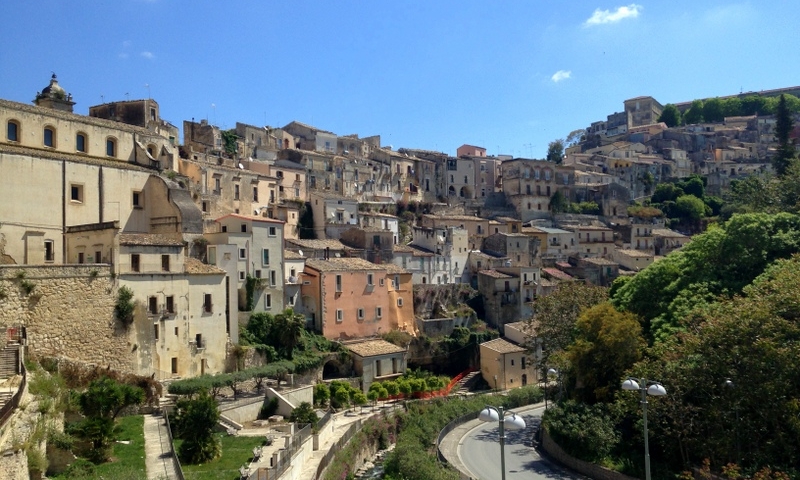Ragusa Ibla, Sicily: Baroque City with an Ancient Heart, Part 4 of 4
All photography by Stephen B. Chambers Architects, Stephanie Chambers
Ragusa Ibla’s panorama is a treasure trove for architects and visitors seeking fine examples of Baroque architecture and Medieval street plan
On the morning we planned to go to Ragusa, a hard rain beat against the windows of our Ortigia hotel. We ached all over from the prior day’s walk through Villa Romana del Casale, a late Roman Empire UNESCO World Site. It was temping to stay perched on the tall chairs place beside the wide windows of our hotel to watch fishermen haul in fresh catch, nosh on Sicilian Breakfast ‘Cookies,’ and sip cappuccino until the waiters swept us out with the crumbs. Although little was written about Ragusa in our guidebooks, it’s history as a cave town for the Sicels (2000-1000 BC ancient Sicilians) piqued our curiosity. We charged up the cameras, packed rain gear into our backpacks and waited for the Renault, il “beeg Sha-neek-wa,” in the hotel lobby. As we navigated “S” turns on the steep climb to the hill town, our jaws dropped when we finally arrived at the city, that tenuously hugged a limestone hill between two deep valleys. “What is this place?” we said in disbelief at the sight of Baroque on top of Baroque, tossed across the edge of the rocky precipice like a jumble of miniature houses in a diorama.
Origin of Ragusa Ibla
Ragusa’s origin can be traced back to the 2nd millennium BC, where Sicels established several settlements. The ancient tribe who populated the 1000 ft. hill came in contact with the nearby Greek colonies and developed the town thanks to the nearby port of Camerina. After a short Carthaginian rule, the Romans and the Byzantines, who fortified the city, built a large castle, and formed an administration for Ragusa. In 848 AD, Ragusa was occupied by the Arabs and remained under their rule until the 11th century, when the Normans conquered it.
Devastation by Earthquake and Rebuilding
In 1693, a major earthquake that killed 5,000of the 10,000 inhabitants, devastated the architecture, too. Following the catastrophe, public opinion was divided on where to rebuild. A compromise was struck. The population divided itself into two new settlements: an upper city called Ragusa Superiore and Ragusa Ibla on the ancient site. The merchant class rebuilt Upper Ragusa and today it is a bustling modern city. The aristocracy refused to leave their devastated homes in the valley and recreated a Baroque city, based on a medieval street plan. The two towns remained separate until 1926.











